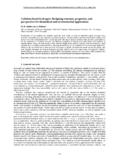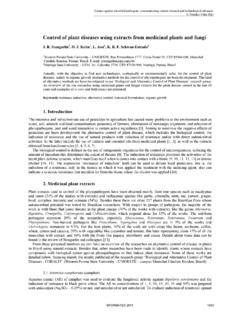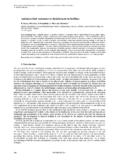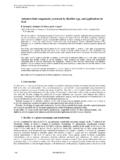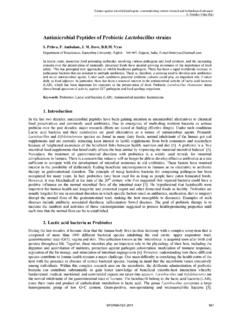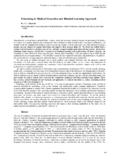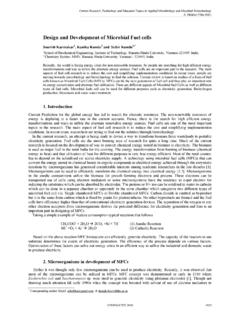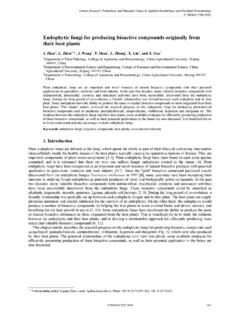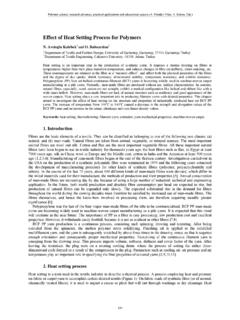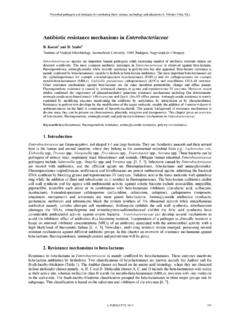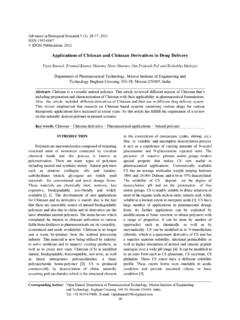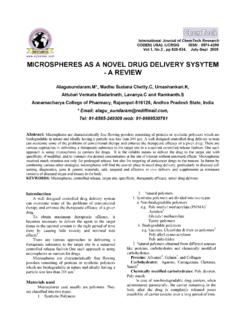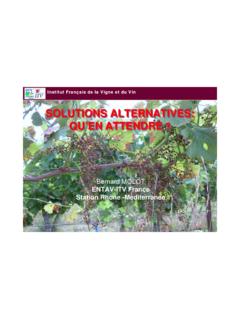Transcription of Edible films: the package of the future? - Formatex
1 Edible films: the package of the future ? Cer n Carrillo and Santiesteban-L pez Benem rita Universidad Aut noma de Puebla. Avenida San Claudio y 22 sur, Jard nes de San Manuel. 72570 Puebla, Puebla, Mexico Nowadays, there is a concern about the methods used for food preservation. One of the most important is that the food industry has been using additives to extend the shelf life of products, which at times, does not turn out to be quite safe, because of the assumption that most of them have health risk associated with cancer, asthma, cardiovascular diseases, allergies, etc.
2 So, their use is justified for the simple fact of reducing costs because of lack of awareness of the producer. In addition, the amount of food waste has increased annually, exacerbating the situation and therefore, increasing the concern of finding the best way to preserve food without changing its physical and nutritional properties at the lowest price. The use of Edible films in the food industry has evolved. Today, the impact they generate, as a means of conservation, is great, because they are composed of polymers, with specific characteristics, of natural origin.
3 They can be polysaccharides, animal and vegetable proteins and lipids, which, when added to food reduce the loss of moisture, also they act as a barrier for CO2 and O2 movement through the food product, and improve they mechanical, physical and nutritional properties of food. On the other hand, they serve as active vehicles for bacteriocins, probiotics, antioxidants and nutrients, each of them having specific benefits in the proper functioning of the organism, optimizing the product for human consumption.
4 Therefore, the present review article has as main objective to highlight the importance of Edible films as packages and their application as vehicles of various bioactive compounds, and discuss whether in the future , they would be one of the best sustainable alternatives for the conservation and commercialization of processed foods. Keywords: Edible films; Edible coating; Edible packages ; active films 1. Why use Edible films? One of the main concerns of the food industry is to find suitable packages to market the food and to keep it in good condition for longer.
5 These packaging are intended to be practical and malleable but with sufficient permeability to prevent food contamination by microorganisms, dust, gases or moisture. Such packaging is expected to prolong the life of the product on the shelf and at the same time retaining its organoleptic properties. Due to increasing pollution and deterioration of resources worldwide in recent years, the industry has opted for organic materials and made from renewable resources to pack their products. Edible films in the food area function as selective barriers for the transference of gases, moisture and nutrients; Are used because they greatly help to reduce the deterioration of foodstuffs caused by environmental factors.
6 Likewise, it is sought to avoid or reduce the oxidation and loss of volatile compounds responsible for specific flavors and properties of food, therefore, the main objective of this chapter is to discuss if Edible films made especially for fresh produce 2. What we know? Nowadays, most consumers are worried about, not just what they eat and its nutritional characteristics, but also, they are worried about if the food that they eat contains some type of hazardous materials and even more, they are worried about its sustainable characteristics.
7 As consumers, we all want to eat fresh products, but what we don t know is how far is the food from the place that has been picked or obtained directly. Now, the time that takes our food to get to our home and to our mouth, could be from hours to days, and this is how the problem begins. As soon as the fruit, vegetable, meat or any animal products are obtained, its aging starts. But, how do we know that some products are fresh? the answers is in its flavor, its appearance and its texture. Therefore, food scientists are focused on generate technologies that maintained product's fresh like characteristics for large periods of time.
8 People have been used some of these technologies for ages. Examples involve, increasing temperature to eliminate pathogens (pasteurization), decrease temperature to prevent bacteria and mold growth (refrigeration and freezing), adding salt or sugar also to prevent bacterial growth (salting and crystallization), etc. The issue with these technologies is that all of them affect either way sensorial quality of food products. So, as an intent to decrease these changes, producer from China in the year 1100, and to maintain Emperor's food fresh (especially citrus fruits) they used molten wax to cover them for long journeys [1].
9 Latter, this practice was extended through Europe, known as larding , in which they also used fats to prevent spoilage, nevertheless, this form to preserve fruits, altered its taste and texture [2]. Then, Japanese used a coat obtained in the processes of boiling soy milk (named yuba) preserving overall quality of food [3]. Later, other technologies came along, such as, smoking, cooling (in iceboxes) and the used of heat. However, coating of products was always a cheap way to maintain their safety and quality.
10 We could now stablish that an Edible film is any primary package (in direct contact with food) used to extend food product shelf life with its quality and sensory characteristics unchanged, with the unique characteristic that could be eaten with the food that contain them. The difference between an Edible film and an Edible coat is that the first is made to function as a wrap or a bag to cover the product and is usually from 50 to 250 mm thick. On the other hand, Edible coating is formed in the product and it could be applied by a variety of method like, brushing, spraying, or dipping.
